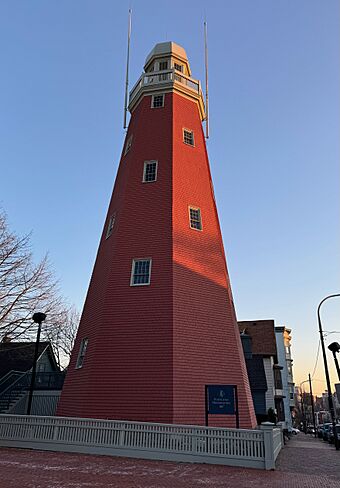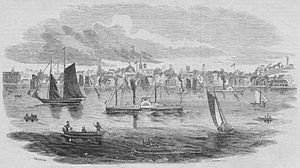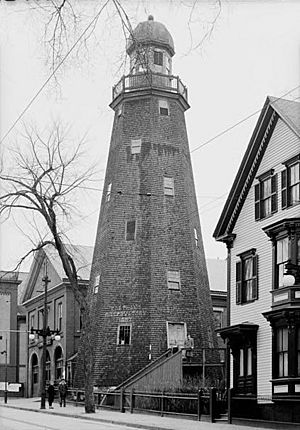Portland Observatory facts for kids
|
Portland Observatory
|
|

The Portland Observatory in 2024
|
|
| Location | 138 Congress St Portland, Maine |
|---|---|
| Area | less than one acre |
| Built | 1807 |
| NRHP reference No. | 73000122 |
Quick facts for kids Significant dates |
|
| Added to NRHP | April 24, 1973 |
| Designated NHL | February 17, 2006 |
The Portland Observatory is a special old tower located at 138 Congress Street in Portland, Maine. It was built way back in 1807. This tower is super unique because it's the only one of its kind still standing in the United States.
Imagine a time before radios and cell phones! This tower helped people on land talk to ships far out at sea. They used a telescope to spot ships and then sent messages using signal flags. This meant people knew a ship was coming hours before it reached the docks. Today, the observatory is a National Historic Landmark and a museum. It's looked after by a group called Greater Portland Landmarks.
Contents
Why the Observatory Was Built
Portland has a deep harbor that's protected by many islands. This was great for ships, but it made it hard for people on the docks to see incoming vessels. Merchants needed to know when their goods were arriving so they could get ready.
In 1807, a clever person named Captain Lemuel Moody came up with a solution. He organized the building of this observatory on Munjoy Hill. From this spot, the tower could see both the wide-open Atlantic Ocean and the docks. During the War of 1812, the observatory also served as a watch tower to look out for danger.
About the Observatory Tower
The observatory is 86 feet (26 meters) tall, which is like a 7-story building! It has an octagonal shape, meaning it has eight sides. This design helps it stand strong against strong winds. It also has a base made of heavy rocks, which keeps it steady during storms.
At the very top of the observatory is a "lantern" or cupola. This is where a powerful telescope used to be. This special telescope could spot ships up to 30 miles (48 km) away! Sadly, that original telescope disappeared in 1939.
The observatory has been fixed up many times over the years. One big renovation happened in 1939. More recently, it was repaired between 1998 and 2000 because of moisture and tiny bugs called powderpost beetles. This repair project even won an award! A central support column was added in 1939 to make it even stronger. In 2014, more work was done on its windows and roof shingles.
The observatory was added to the National Register of Historic Places in 1972. Then, in 2006, it was given the special titles of National Historic Landmark and a National Historic Civil Engineering Landmark.
How the Tower Used to Work
The Portland Observatory is the only maritime signal station left in the United States. Back in the day, shipping merchants paid a yearly fee to use the tower. They would store their company flags there. When their ship was spotted, the observatory staff would hoist their flag up a flagpole. This told everyone on shore that their ship was arriving.
Later, a telephone was installed, which helped the tower keep working until 1923. By then, ships had more reliable engines and could communicate by radio. This made the old signal tower less necessary.
In 1937, the tower was given to the city of Portland. For many years, it was often unlocked, and local kids loved to play inside. Some older people still remember carving their initials into the wood! During the latest big restoration, workers tried to keep as much of the original wood as possible. You can tell the old wood by its darker color, while the newer wood is lighter.
Visiting the Observatory Today
Today, a non-profit group called Greater Portland Landmarks takes care of the building. You can take a guided tour to learn all about the observatory's history and the neighborhood. These tours are given by friendly volunteers from late May to early October. There's a small fee to go inside.
On clear days, the view from the top balcony is amazing! You can see all the way out to the ocean and even inland to Mount Washington.
See also



